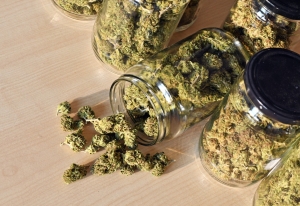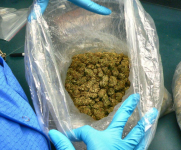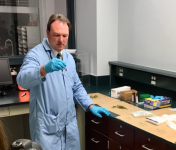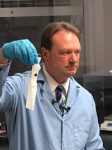Hemp & Marijuana

Cannabis sativa has been cultivated for both its psychoactive properties (marijuana) and as a source of fiber (hemp). Both cultivars, marijuana and hemp, are the same plant - Cannabis sativa. Tennessee has legalized the cultivation of hemp and defined hemp as Cannabis sativa containing less than 0.3% THC. Marijuana, Cannabis sativa containing greater than 0.3% THC, is still illegal in Tennessee.
TBI, and other crime labs, have historically performed plant material testing by microscopically looking for unique botanical characteristics and performing a color test for compounds exclusive to Cannabis sativa. This historic testing is relatively quick and inexpensive.
Differentiating between hemp and marijuana is a topic of great interest for crime labs on a national scale. It is influenced not only by federal law, but by the laws of each individual state.
Tennessee is on the leading edge of developing crime laboratory methodology to cope with this challenge and is one of few states currently performing THC quantitation on plant material in a state crime lab. We were assessed in THC quantitation by our laboratory accrediting body (ANAB) in July 2019 and expect to receive accreditation for the TBI Nashville Crime Lab in THC quantitation by the end of 2019.
Frequently Asked Questions
CBD, or cannabidiol, is a chemical compound from the cannabis plant. Unlike tetrahydrocannabinol (THC), it's not psychoactive.
THC, or tetrahydrocannabinol, is the principal psychoactive chemical of the cannabis plant.
Tennessee has legalized the cultivation of hemp and defined hemp as Cannabis sativa containing less than 0.3% THC.
Marijuana, Cannabis sativa containing greater than 0.3% THC, is still illegal in Tennessee.
TBI currently uses a three-step testing protocol. (See more below). TBI, like other crime labs, has historically performed plant material testing by microscopically looking for unique botanical characteristics and performing a color test for compounds exclusive to Cannabis sativa. This historic testing is relatively quick and inexpensive.
We perform a second color test to estimate the THC to CBD ratio. Marijuana has a high ratio of THC to CBD (typically 9:1 or greater) and will turn the second color test blue. Hemp has a lower ratio of THC to CBD and will turn the second color test red.
Essentially, hemp has a high amount of CBD and a very small amount of THC. Marijuana has a large amount of THC and a relatively small amount of CBD. The color test used in TBI's crime laboratories indicates the difference between the two based upon that ratio, but does not indicate the actual percentages.
Testing to determine the quantitative THC percentage in plant material is both expensive and time-consuming, with regard to equipment and personnel. We are currently performing THC quantitation instrumentally on limited plant material samples at the Nashville Crime Laboratory. THC quantitation is being performed only at a District Attorney General’s request, as they are better suited to evaluate the circumstances and needs surrounding arrest and prosecution.
Yes. TBI currently tests misdemeanor amounts, and will continue to quantify THC content in submitted misdemeanor amounts at the request of the respective District Attorney General.
TBI is opposed to the legalization of marijuana in any form outside of the FDA and DEA approval process utilized for all other forms of medicine.
TBI's Testing Process
The Tennessee Bureau of Investigation uses a three-step protocol for submissions of plant material.
Presumptive Testing
In addition to traditional microscopic analysis and color test, TBI performs a second color test to estimate the THC-to-CBD ratio. Marijuana has a high ratio of THC to CBD (typically 9:1 or greater) and will turn the second color test blue. Hemp has a lower ratio of THC to CBD and will turn the second color test red.
Color Test Demonstration



Samples testing positive for the microscopic and both color tests are reported as: Cannabis – Visual and chemical color testing presumptively indicate the exhibit is marijuana.
Samples testing positive for the microscopic but negative for the new color test are reported as: Cannabis – Visual and chemical color testing presumptively indicate the exhibit is hemp.
Additional testing will only be performed at the District Attorney General’s request.
Threshold Testing
(Greater or Less than 1.0%)
Samples requiring further identification will be instrumentally analyzed along with a known, 1% THC control standard to estimate the THC concentration. (This is the same method used by DEA).
Quantitative Analysis
(0.1% to 1.0%)
Some samples may be candidates for full, instrumental, quantitative THC testing, in which the total THC level will be reported.
Laboratory Statistics
From 2005 to 2018, the statewide TBI Crime Laboratory Forensic Chemistry Unit identified plant material as marijuana an average of 9,951 times each year. This number has been relatively consistent over the years.
| 2005 | 10,505 |
| 2006 | 11,632 |
| 2007 | 11,885 |
| 2008 | 10,605 |
| 2009 | 10,274 |
| 2010 | 9,477 |
| 2011 | 8,655 |
| 2012 | 9,458 |
| 2013 | 10,090 |
| 2014 | 8,622 |
| 2015 | 8,798 |
| 2016 | 9,241 |
| 2017 | 9,414 |
| 2018 | 10,652 |
Additionally, the statewide TBI Crime Laboratory Forensic Chemistry Unit separately identified THC 497 times in 2018. THC is typically identified in samples that are not plant material, such as food stuffs, vape cartridges, oils, etc. THC identification has increased dramatically from 2005 to 2018.
| 2005 | 16 |
| 2006 | 39 |
| 2007 | 35 |
| 2008 | 36 |
| 2009 | 51 |
| 2010 | 51 |
| 2011 | 99 |
| 2012 | 107 |
| 2013 | 160 |
| 2014 | 196 |
| 2015 | 318 |
| 2016 | 340 |
| 2017 | 364 |
| 2018 | 497 |